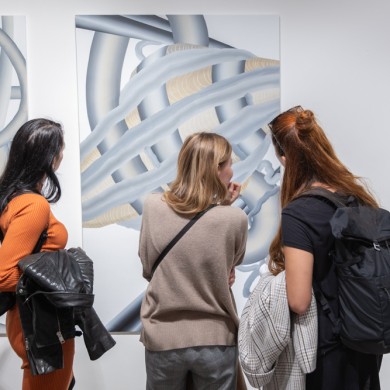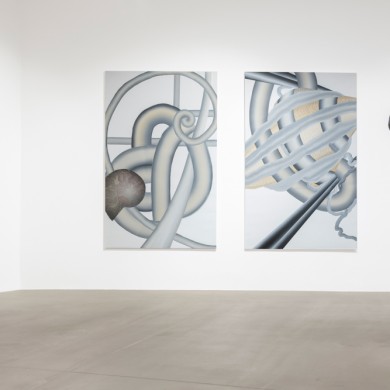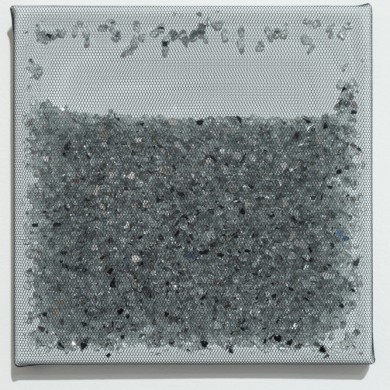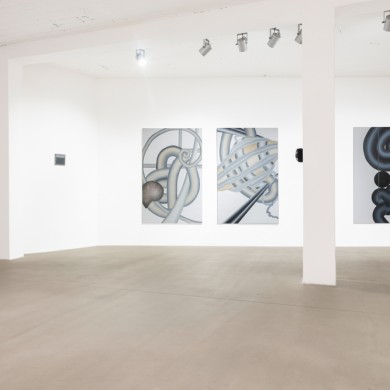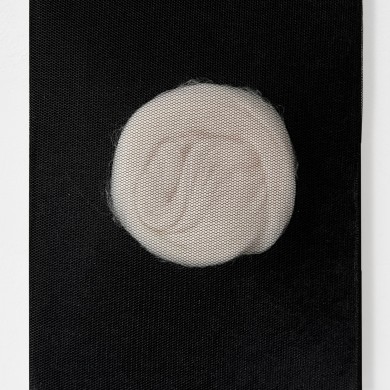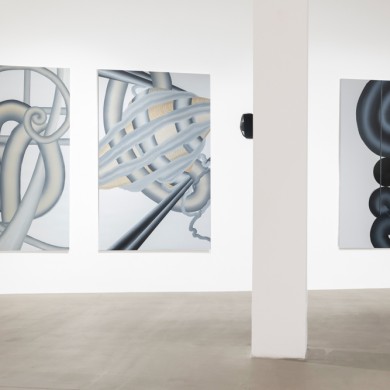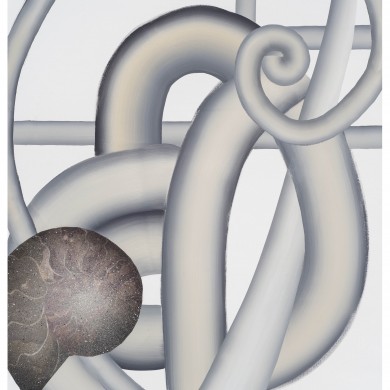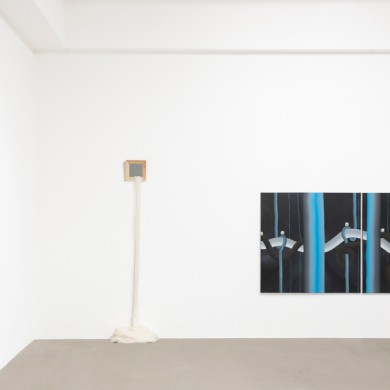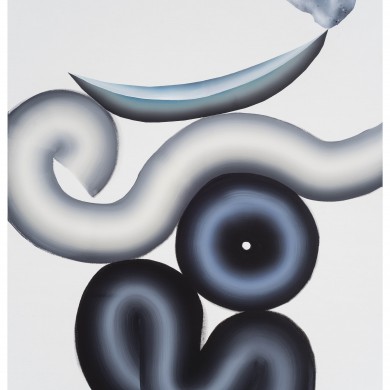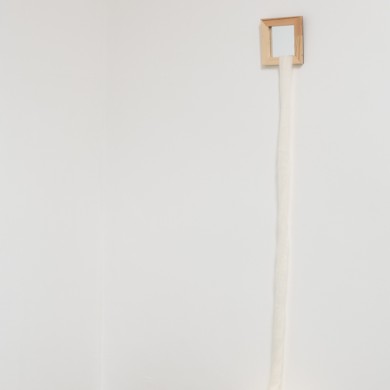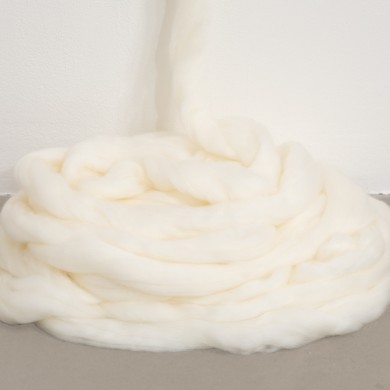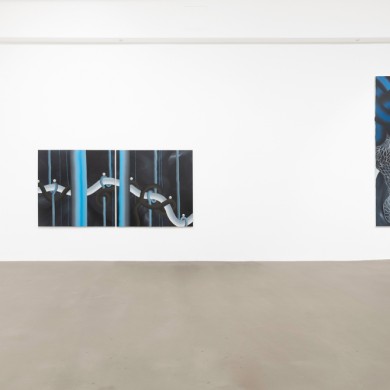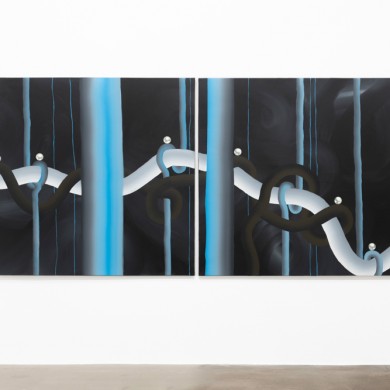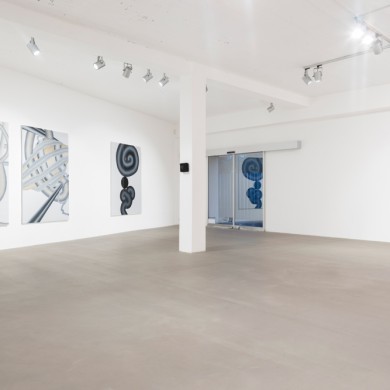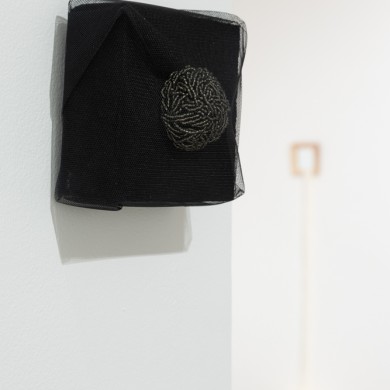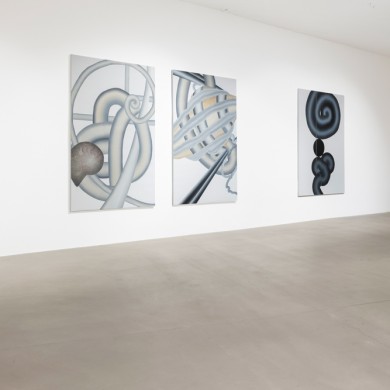Mars is No fun | Sara Zahorjanová
kurátorka: Terezie Nekvindová
25 Oct 2023 – 12 Jan 2024
ZAHORIAN & VAN ESPEN Bratislava
Absolútnu rovnováhu nie je možné dosiahnuť. Napriek tomu sa väčšina z nás pokúša o každodenné vyvažovanie vychýleného sveta: od hľadania rovnováhy v medziľudských vzťahoch cez balansovanie vlastnej duševnej vyrovnanosti, snahy o udržateľný spôsob života na Zemi, usilovanie sa o spravodlivosť až po napríklad banálnu vyváženosť stravy. Rovnováha je vo svojej podstate vždy krehká, rovnako ako naša planéta alebo ľudské vnútro.
Práve tento stav Sara vyjadruje vo svojich oslobodených, monochromatických maľbách. Konštruuje v nich situácie odohrávajúce sa v neidentifikovateľných mikro či naopak makro svetoch. Hlavnú úlohu v nich hrajú organické tvary pripomínajúce hadice, tepny, korene alebo vodiče energií. Vzájomne sa splietajú, občas ich drží tenký povrázok, inokedy sa tiahnu úplne slobodne. Sú hladké alebo majú podobu zvlečenej hadej kože. Vidíme iba výrez, väčšinou nevieme, kde majú začiatok a koniec. Je to zrejme len malá časť väčšieho systému. Možno nekonečného. Spolu s nimi v obrazoch levitujú archetypálne predmety ako loď symbolizujúca Noemovu archu, perla znamenajúca čistotu a nevinnosť, fosílie poukazujúce na zodpovednosť človeka pri zaobchádzaní s planétou alebo asteroid ako symbol vesmíru. Sara sa tak pohybuje v širokom priestore medzi hlbokou minulosťou a dystopickou budúcnosťou, spája večnosť s prítomnosťou.
Aj keď môžu obrazy pôsobiť na prvý pohľad čisto ako hra s formou, v ich pozadí je obsiahnutý záujem o aktuálne problémy našej civilizácie. Každé dielo je pomerne silným a vyhraneným „statementom“. V ich spracovaní je poznať autorkino školenie v grafike (na AVU prešla z Knížákovho ateliéru k Jiřímu Lindovskému a absolvovala u Dalibora Smutného). Takmer absentuje priestor a z veľkej časti sa pohybujeme v čiernobielej škále. Z diaľky alebo v reprodukcii môžu obrazy pripomínať počítačom generované snímky či dizajn, pri bližšom pohľade ale nachádzame výrazné maliarske kvality. Samotný akt maľby je pre autorku podstatný: „…painting is such a distressing utopia/addiction/privilege/passion/unfinished sympathy. / it’s a mess.“, píše v jednej zo svojich básní.
Popri týchto veľkoformátových maľbách, do ktorých je možné sa takmer fyzicky ponoriť, Sara tvorí menšie „denníkové záznamy“. Nie sú to denníky v pravom slova zmysle, že by v nich zaznamenávala svoje bežné či neobyčajné zážitky (azda len s výnimkou zážitku z hudby). Ide skôr opäť o mikropríbehy, väčšinou romantickej povahy – vzťah dvoch zamilovaných, stratený náhrdelník, nočný dážď, kvitnúca rastlina, schúlený Mesiac, rozbité zrkadlo. Nápadito pritom pracuje s materiálmi od zamatu cez polyuretánovú penu a ovčiu vlnu, až po výšivku z korálikov a polodrahokamov. Hapticky bohaté diela nabádajú k intímnemu stretnutiu aj tým, že mnohé z nich zrkadlia podobu toho, kto sa na ne pozerá. Do výstavy Sara zaradila aj objekt vstupujúci do priestoru, v ktorom sa pomyselne zhmotnili línie z jej malieb.
Projekt podporil z verejných zdrojov Fond na podporu umenia ![]()
Mars is No fun | Sara Zahorjanová
curator: Terezie Nekvindová
25 Oct 2023 – 12 Jan 2024
ZAHORIAN VAN ESPEN Bratislava
Absolute Equilibrium cannot possibly be achieved. And nevertheless most of us make a daily attempt to correct the tilt of a skewed world: from seeking balance in interhuman relationships, through the steadying of our own mental composure, seeking a sustainable way of life on Earth, striving for justice, to the perhaps banal matter of a balanced diet. Equilibrium in essence is always fragile, just like our planet or the inner human being.
It is this condition that Sara expresses in her unembellished monochromatic paintings. She constructs situations that are played out in unidenfiable micro, or alternatively macro, worlds. Organic shapes reminiscent of hoses, arteries, roots or cables, play the principal roles. They entwine together, sometimes held by a thin string, at other times pouring out freely. They are smooth, or they have the form of sloughed-off snakeskin. We see only a cutout and most of the time we do not know where it begins or ends. Most probably it is only a small part of a larger system. Possibly infinite. Together with these, archetypal objects levitate in the paintings, such as a ship signifying Noah’s ark, a pearl representing purity and innocence, fossils adverting to mankind’s responsibility for its treatment of the planet, and an asteroid as a symbol of the cosmos. Sarah is thus moving in a broad space between deep past and dystopian future, linking eternity with the present.
While the paintings at first glance may give the impression of being purely a play of form, concern with the current problems of our civilisation is there in the background. Each work is a relatively strong and well-defined statement. In her manner of working one can detect the artist’s training in graphic art (at the Prague AVU she transferred from Knížák’s studio to Jiří Lindovský and graduated with Dalibor Smutný). Space is almost absent, and in large part we are moving in a black-and-white scale. From a distance, or in reproduction, these images may resemble computer-generated shots or designs, but when we look more closely we find striking painterly qualities. The act of painting itself is fundamental for this artist: “…painting is such a distressing utopia/addiction/privilege/passion/unfinished sympathy. / it’s a mess”, she writes in one of her poems.
Alongside these large format paintings, where one can almost “immerse” oneself physically, Sara produces smaller “diary entries”. These are not diaries in the proper sense of the word, meaning that they record her usual or unusual experiences (with the exception, perhaps, of her experience of music). Again, what they contain is rather micro-stories, mostly of a romantic nature: the relationship of two lovers, a lost necklace, night rain, a flowering plant, curled up Moon, crushed mirror. She works strikingly with materials ranging from velvet, via polyurethane foam, to embroidery with beads and semi-precious stones. These haptically rich works invite us to an intimate encounter, not least because a series of them mirrors the form of the person who is looking. Sara has also included in the exhibition an object entering the space, where she imaginatively materialises lines from her paintings./ Terezie Nekvindová
The name of this exhibition refers to the song Mars Is No Fun by the French singer and composer Camille Dalmais
You can’t go to the beach
Not enough water
You can’t open the window
There’s no air outside the bungalow
They didn’t mention it
On the brochure
Got trapped here when I moved
Five years ago
Mars is no fun
They said “Everything is pure out there
You’ll be the first
Human beings to show the world
There’ s life outside of Earth”
But the Greens don’t like us
They want us to leave the place
Will you get my postcard Before Christmas?
Mars is no fun
I want to go back on Earth
And live with you
In our social housing
And wander all afternoon
In the shopping mall
Of Milton Keynes
Mars is no fun
You can’t really move here
The law of gravity
Is much much stronger
It’s like a tragedy
You’re grounded on the ground
If you kiss, it’s forever
And if you do it on a bed…
do you get the picture?
Mars is no fun
